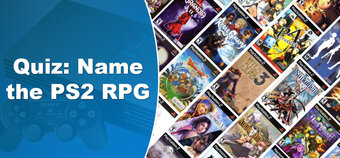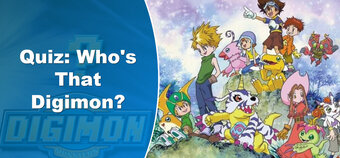The final few years of the Playstation 3's life have seen a surprising number of collections coming out - whether it's the Final Fantasy X/X-2 remasters, Kingdom Hearts remakes or a collection of Ratchet & Clank games, these compilations are great for giving newcomers the perfect opportunity to catch up on franchises they may have missed the first time round - especially if they're late to the Playstation party,like us. But not all of them are necessarily games from older consoles - as this new collection shows. Following on from their Atelier collection, the folks at NIS America have another similar collection, this time stuffing all three of their Hyperdimension Neptunia games onto a single disc, entitled the Hyperdimension Neptunia Hypercollection.
While it may seem like a strange move to some, as, much like the Atelier series, enhanced all-downloadable-extras-included remakes have appeared on the PS Vita in recent years, bringing a whole host of improvements over their original PS3 versions (particularly in the case of the first Hyperdimension Neptunia game), for those of you who haven't leapt on the Vita bandwagon yet - or those that would prefer games that aren't download only and eat up huge chunks of your miniscule memory card - the PS3 may still be the better option, letting you net all three games for the price of one.

Just an average day in the land of Hyperdimension Neptunia...
On the whole, the Hyperdimension Neptunia series has perhaps the weirdest setting for a game we've ever come across. Set in the midst of a console war in the land of Gamindustri, personified games console Goddesses fight for total control of the land, whilst fending off the threats of piracy, criminal organisations, and parallel dimensions along the way. Whilst the strong-minded Noire, MMO-obsessed Vert and quiet and reserved Blanc, the deities of Lastation (Playstation), Leanbox (Xbox) and Lowee (Wii) all feature heavily, the star of the show is most definitely the kooky, crazy, purple-haired Neptune, the Goddess of the Sega-themed Planeptune, named after a cancelled console of the mid-90s, the Sega Neptune. Chock-a-block with references to games and the game industry as a whole, full of fourth-wall-breaking dialogue and all wrapped up in a cutesy kawaii exterior, it makes for a surprisingly entertaining - and unusual - role-playing game.
A word of warning for the easily offended out there though - the Hyperdimension Neptunia games are famed for their scantily-clad all-female cast, innuendo and fanservice-y upskirts, bath scenes and potentially provocative imagery. At some point during the game, it's pretty much guaranteed there'll be at least one argument about breast sizes, an angry fit put down to menstruation, and talk of fitting things in mouths. It's all meant in good fun, but such references may not be to everyone's taste, we suppose.

Aren't we all...
Hyperdimension Neptunia
The first Hyperdimension Neptunia opens with the four Goddesses locked in a long series of conflicts known as the console war. Electing to remove one of the Goddesses to try and relieve the stalemate, everyone gangs up on poor Neptune, throwing her overboard to the world below, where she's found by clumsy trainee nurse Compa, who promptly diagnoses Neptune with a case of amnesia, in typical Japanese role-playing game style. Learning that monsters have been growing increasingly restless and attacking people, the pair set off on a journey to find out what's causing the problem, joining up with treasure hunter IF along the way. But before long, they discover there's a much more sinister force at work, and, under the watchful eye of a talking book-come-fairy called Histoire, they set off to reunite the Goddesses of Gamesindustri and save the world.
Working out where to go during your travels around Gamesindustri can be a bit awkward though, given that it's split over two separate menus. 'Explore' effectively gives you a feed of general goings on, side quests and story segments, all mixed together with no labelling whatsoever, while 'Search' simply gives you a list of the game's dungeons, with little more than the title of the corresponding quests to differentiate them by - meaning a lot of backwards and forwardsing between menus, trying to match quests to locations. Once you decide on a dungeon, you'll find yourself in a pretty standard maze-like dungeon, in which you'll need to either defeat a certain boss, find an exit or locate a specific item. Each character has their own unique 'Dungeon Skill' which comes in handy too - Neptune's hammer can smash through destructible barriers, Compa's bell is great for luring out hiding monsters and bosses and IF's search skill comes in handy for revealing hidden treasure.

Here Mister Monster!
Every so often while exploring, you'll get attacked by enemies at random, triggering Hyperdimension's battles, in which you and your opponents taking it in turns to attack each other. What's interesting about Hyperdimension though is it's combo system - instead of picking from a set list of actions each turn, you can create your own mix of attacks by pressing different combinations of buttons to mash up melee, ranged and weapon-based attacks for different results, with each attack costing a chunk of your character's Action Points, a bar which dictates the amount of actions you can take before your turn ends. You can also customise things even further by chopping and changing the attacks and skills used at each stage of each combo, even adding in a handful of 'Disc Skills', which call on the power of a famous game character for extra damage. Oldies like Fantasy Zone, Alex Kidd and Space Harrier from the basis of Nep-Nep's Sega-themed special attacks, appearing alongside a few more obscure references, such as the explosive 'Prinny' penguins and ditsy blonde fallen angel Flonne from the Disgaea series. Each of the Goddess characters - Neptune, Vert, Blanc and Noire - also have their more powerful CPU forms they can change into mid-battle, boosting their stats considerably.
But perhaps the biggest issue with Hyperdimension Neptunia is it's as good as broken healing system. Instead of simply collecting potions or casting healing spells when your health's looking a bit low, your characters automatically heal themselves when damaged - at least in theory. You have to set a percentage chance for each healing skill (and there are many different varieties) to activate once your health drops below a certain point, but the problem with this is that, particularly early on, you don't have enough points to pour in to the skills to make healing even remotely reliable. At most, you can whack it up to 50% and pray Compa's First Aid activates before she gets obliterated, as, for some illogical reason, the skills only activate after you've been hit. So, if you're against a particularly nasty enemy and it fails to go off once or twice - as it could easily do at a 50% chance - you'll be dead through no fault of your own. Any fallen members will be brought back with 1HP in the next battle, but, when the only way to heal is after being hit in battle, you tend to get stuck in a vicious cycle of repeatedly dying. As you get further into the game, amassing enough points to set your most useful heal skill to 100% activation, it gets a bit easier - although even then, you can only really max it out at the expense of other potentially useful skills, such as those which nullify poisoning or paralysis, or revive fallen comrades. It's a system that seems way too complicated, unreliable and random to be workable, and is easily the most frustrating aspect of the whole game.
Hyperdimension Neptunia mk2
For the second game, the Goddesses are in trouble - held captive in the Gamesindustri Graveyard for the past three years, their believers have been slowly going over to the dark side, weakening their powers. With the Arfoire Syndicate of International Crime gaining traction, spreading their piracy across the land, Compa and IF attempt to resurrect the Goddesses - but find they only have the power to revive Neptune's younger sister, Nepgear. They then head off on a journey across Gamesindustri to recruit the other CPU's younger sisters and locate each world's mascot, the only beings with the power to free the trapped CPUs. Along the way, they also need to reawaken people's faith in the lost Goddesses to reduce ASIC's power via the 'shares' system - which basically means a lot of hard graft completing various fetch quests and monster slaying missions for the people of Gamesindustri to win them over and save the world.

In mk2, it's the turn of the CPU's little sisters to save the day.
However - completing quests doesn't necessarily always decrease Arfoire's hold, and may cut into other Goddesses' shares instead, so you'll need to pick and choose your quests appropriately to try and balance out the power share of Gamesindustri. The bulk of your time in mk2 will be spent exploring the many maze-like caves, fields and forests of each landmass, battling monsters, collecting items and harvesting raw materials (which can then be synthesised into new items in town) to complete quests, gain shares and generally progress the story. While the individual dungeon skills of the previous game have largely been scrapped, Nepgear does have the ability to send out a pulse of purple light to reveal any hidden rare items nearby.
Battles have also been reworked slightly too - while still turn-based, instead of occurring at random, they're triggered by touching the enemies which roam the fields and dungeons. When in a battle, you now have more control over your party members' positions, moving them to the best places from which to attack - perhaps lining up powerful characters so they hit multiple enemies at once, or moving weaker healing characters (ie. Compa) further away from the fray. Attacks are still largely combo based, although this time round, each button-based move has it's own advantages - one focuses on power, another on speed and multiple attacks and a final on breaking down enemies' defences, making them take more damage. As before these can be mix and matched as you see fit, with certain combinations ending in more powerful finishers and fancy skills - which are, as before, totally customisable. mk2 even brings a load more crazy special attacks to the table, such as the ludicrous Inafune Brand, which lets you whack enemies with an oversized sword version of the game's producer. There's plenty of other nods to video games too, from the Piranha Plant-style enemies you encounter to Neptune humming the Final Fantasy level up tune whenever she gains a level to the very existence of the CPU Candidate sisters - one for each of Sony, Nintendo and Sega's handhelds, while Xbox Goddess Vert is an only child.
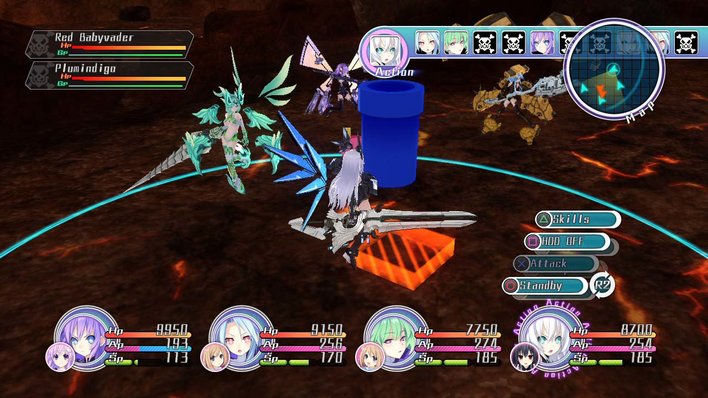
The hatched area on the ground shows the area of affect of your attacks.
Adding another layer to battles, the new partnering system lets you pair up characters so that one fights whilst the other provides support effects from the sidelines, buffing up their partner's abilities. For example, a pair of Nepgear in front and Compa in the rear will give Nepgear a resistance to any stat decreasing moves enemies throw at her - whilst pairing Neptune and her sister Nepgear together basically breaks the game, disabling the damage limit (so you can hit more than 9999 damage) and giving you access to a rather overpowered team finishing move. And, thankfully, the confusingly random healing system of the first game has now been replaced by much more conventional healing items and skills which can be used whenever you need them - yay!
Hyperdimention Neptunia Victory
This time round, peace has come to the world of Gamindustri - which means the Goddesses have been slacking off playing games all day, rather than actually getting any work done (we know that feeling!). During some enforced labour in the forest, Nep-Nep gets sucked through a portal and into another world - one where the lands of Leanbox and Lastation no longer exist and Lowee courts with criminals. And in this alternate dimension, Neptune is no longer the Goddess of Planeptune either, with the rather naïve and childlike Plutia taking her place as CPU. If Neppy can manage to put down a controller and step up her game, maybe - just maybe - she'll find a way back home.
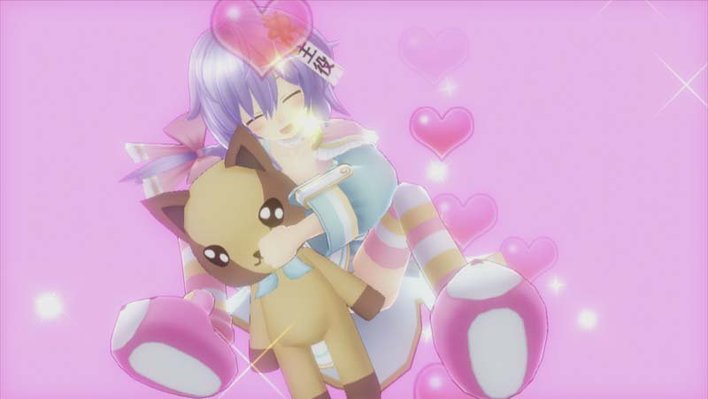
Plutia may look cute and cuddly on the outside, but looks can be deceiving...
In terms of gameplay, Hyperdimension Neptunia Victory is nearly identical to it's predecessor, Hyperdimension Neptunia mk2. Most of your time is spent either running through dungeons or listening to conversations between the characters as they talk, talk and talk some more. Completing quests from the town's Guild is much the same as it ever was, with rewards of money, items and Gamindustri shares when completed- which serve only to power up the corresponding Goddesses in battle, and don't play into the story as heavily as with the predecessor. As you explore the brightly-coloured dungeons, caves and forests there is one new addition though - a jump, which lets you leap up and down small ledges to reach new areas. Or in our case, lets us hop, skip and jump from one end of the field to the other, looking ridiculous and accidentally leaping into all the local wildlife in the process.
As always though, Gamindustri's monster inhabitants - the Dragon Quest slime-alike Dogoos, space invader clones and Piranha Plant-style enemies to name but a few - are all spoiling for a fight, and you'll find yourself in plenty of battles during the course of the game. Essentially a carbon copy of the combat system we saw in it's predecessor, Victory's turn-based battles are pretty fun, as you play with positioning, mess with button combos and spam crazy special attacks. A bit of strategy can pay off too, as you try to place your characters such that they damage as many enemies as possible with each attack, but in such a way so as to avoid any larger range, wider area-of-effect moves your enemies might send your way. In terms of crazy specials, the game developers make more than a few appearances, whether it's shooting your enemies with lasers from Megaman creator Inafune's eyes, whacking them with an oversized drill emblazoned with Endo's funny face (the guy behind retro space shooter Xevious), or simply transforming into your super-powered HDD form and beating the stuffing out of your opponents.
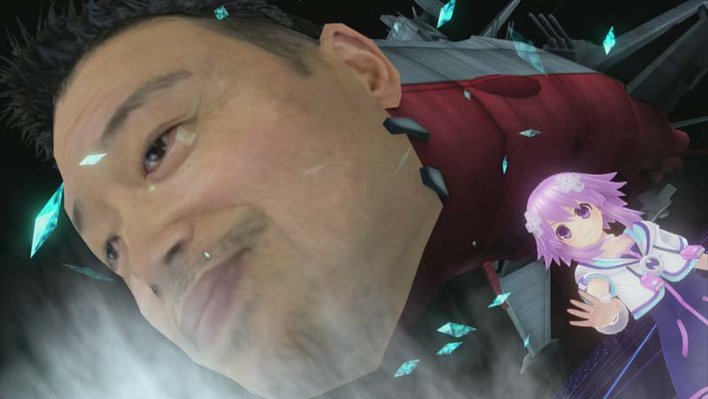
One of the strangest special attacks ever...
Just like in mk2, characters can pair up in battle, one in the front, and one in the rear to share abilities. While the girlie in front does all the hard graft, beating up the enemies, the one in the back boosts their performance with a variety of skills - such as paralysis immunity, increased experience points and the like, varying from character to character. The longer the pair fight together, the stronger their friendship level becomes, and the better support effects you unlock - although it's still worth experimenting with pairs, as certain couples have their own special attacks. It's an ingenious way of making use of those extra party characters you accumulate during your adventure, which are often left to languish down the bottom of the list while your preferred battle party takes all the glory.
Summary
The first Hyperdimension Neptunia is unfortunately a bit of a mixed bag. Fun characters, witty writing and an impressive amount of fourth-wall breaking references to games are marred by a broken healing system, lacklustre dungeons and confusing menus, maps and customisation options - it's not necessarily unplayable, but it's not all that great either. Fortunately, both Hyperdimension Neptunia mk 2 and Hyperdimension Neptunia Victory are miles better, taking the light-hearted story and characters and mixing it with a vastly improved combat system to make what are some seriously solid entries in the series. The large amount of anime silliness, fanservice upskirts and jiggly chests may not be everybody's cup of tea, but if you like your games a little different, than the Hyperdimension Neptunia Hypercollection may just be right up your street.
Format Reviewed: Playstation 3







